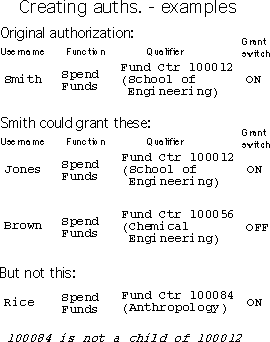The Roles Database
at the
Massachusetts Institute of Technology
Jim Repa
repa@mit.edu
September 18, 1998
Additional information available at http://web.mit.edu.ezproxyberklee.flo.org/rolesdb
Contents
- What does it do?
-
Creating and disseminating authorizations
-
Enforcing authorizations
-
What is an authorization?
-
Why have a qualifier?
-
Why not have more than one qualifier per authorization?
-
Qualifiers fit into hierarchies
-
Creating and delegating authorizations
-
Creating auths -- examples
-
Where are we today?
What does it do?
- Provides a central facility for maintaining information on people's roles or authorizations for (some) computer-based applications.
- Disseminates authorization information to the systems that need it.
- Supports an environment where there are many people with similar roles but in different departments.
- can distribute role/authorization maintenance to local department people who understand their departments.
Creating and disseminating authorizations

- Supporting information is fed nightly from data warehouse to Roles DB
- Front-end application is used to create "authorizations" in the Roles Database
- Authorization information is converted, and sent to various application
Enforcing authorizations
- After authorization information is
converted and sent to each
application system, the Roles DB is
out of the picture.
- For each system, users connect
(authenticate) using their
Kerberos username (or for
Web applications, a certificate
containing their username)
- Each system checks authority to
perform each transaction by
comparing the username and desired
function and "qualifier" against its
locally stored table of authorizations
What is an authorization?
Authorization = Person + Function + Qualifier

Examples:
- Jane Doe can review purchases for account #12345
- Harry Firestone can view employee records for Dept. of Materials Science
- Ebenezer Scrooge can edit the budget for Sloan School of Management
Why have a qualifier?
- Often, people are authorized to do a function only within an organizational unit (school, dept., lab, etc.) or an account number. Functions are similar in different departments, but we need a way to differentiate between them.
- With qualifiers, we only need a small number of functions, and can keep the logic simple for processing them.
Why not have more than one qualifier per authorization?
- One qualifier is a good compromise between simplicity and understandability vs. versatility.
- We think most useful authorizations will only need one qualifier.
- If the "2nd qualifier" only has a few possible values, we can build them into the function definition, e.g.,
- Anne can do reqs. for < $5K for account #34512.
- Bob can do reqs. for < $10K for account #34512.
- Chris can do reqs. for any amt. for account #34512.
Qualifiers fit into hierarchies
- Organizational units are hierarchical:

- Account numbers are also grouped. Their structure is a "web" rather than a strict hierarchy, ie., an account number can be a member of mor than one group.
Creating and delegating authorizations
- Each authorization has a "grant"
switch that determines whether the
owner of that authorization can grant
it to others
- If the "grant" switch is turned on,
the owner can grant a new
authorization where:
- Person is anybody at MIT (with a
Kerberos username)
- Function is the same function as
that in the original authorization
- Qualifier is the either the same
qualifier or one of its descendents
in the hierarchy
- Grant-switch is either ON or OFF
Creating auths -- Examples

Where are we today?
- SAP financial system
- Roles DB used for maintaining auth. information since June, 1998
- There was initial resistance, but now most people "like it"
- School of Management and a group of Engineering administrative officers are using Roles DB directly
- Most maintenance is still done centrally by a small group of SAP administrators plus a few "school coordinators"
- More distribution to departments planned for January, 1999
- Graduate Admissions system
- Central maintenance today.
- Plans for distribution in future
- Data warehouse
- Will soon share SAP authorizations for control of viewing financial data
- Roles DB will soon control auths. for viewing of personnel data; authorizations maintained by Personnel Department
- Converted authorizations used as a joined table for VIEWs of data
- Other systems under development likely to use Roles DB:
- Web-based budget planning system
- More Registrar-sponsored systems
- More central IS infrastructure systems
- Who knows what else?
Last modified by sbjones@mit.edu on October 2, 1998.



